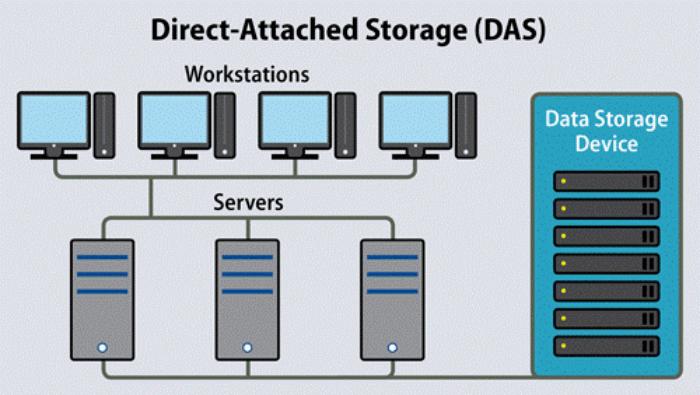Direct Attached Storage (DAS) is an essential component in various computing environments, providing local storage directly connected to a server or workstation. Maximizing DAS storage performance is critical for efficient data access and system operations. This article aims to explore ten key strategies that can significantly enhance DAS performance, ensuring optimized functionality for storage in various setups.
Implement High-Performance Disk Drives
The choice of storage drives significantly impacts DAS performance. Solid State Drives (SSDs) offer faster read/write speeds compared to traditional Hard Disk Drives (HDDs). Further advancements, such as NVMe (Non-Volatile Memory Express), provide ultra-fast data transfer rates, significantly boosting DAS performance.
RAID Configuration for Performance and Redundancy
Utilizing RAID configurations in DAS setups ensures both performance and data redundancy. RAID 0, for example, enhances performance by striping data across drives, while RAID 10 offers a combination of performance and fault tolerance.
Utilize Multi-Path I/O (MPIO)
Multi-Path I/O (MPIO) enables the simultaneous use of multiple paths to the storage device. This load balancing technique optimizes throughput, enhancing data access and performance by efficiently distributing I/O operations.
Optimize File System and Block Sizes
Selecting appropriate file systems (such as NTFS, EXT4) and block sizes is crucial. Correct file system and block size configurations significantly impact read/write performance, ensuring efficient data transfer within the DAS environment.
Cache Mechanisms for Accelerated Access
Caching mechanisms play a pivotal role in enhancing DAS performance. Whether it’s write-back, write-through, or read cache, these caching strategies help speed up data access, optimizing I/O operations for increased efficiency.
Maximize System Memory and Buffering
Increasing system memory aids in reducing disk I/O operations. Caching data in system memory minimizes read/write accesses to the disks, enhancing DAS performance by boosting data retrieval and storage efficiency.
Optimal Hardware and Firmware Updates
Regular updates of hardware components, such as RAID controllers, and firmware ensure the system is running at peak performance. Outdated hardware or firmware can hinder DAS functionality, emphasizing the need for continuous updates.
Load Balancing and Traffic Management
Effective load balancing strategies distribute I/O operations evenly across drives, optimizing performance. Implementing traffic management tools and techniques ensures controlled data access, improving efficiency in multi-user environments.
Tuning and Optimization Techniques
Fine-tuning DAS systems using I/O scheduling and kernel parameter adjustments significantly enhances performance. Utilizing performance optimization tools and utilities allows system administrators to optimize DAS performance effectively.
Monitoring and Performance Analysis
Regular monitoring and analysis of DAS performance identify bottlenecks and system issues. This continuous assessment ensures sustained high performance, allowing for prompt troubleshooting and improvements.
Software-Defined Storage (SDS) for DAS
Implementing Software-Defined Storage (SDS) technology can revolutionize DAS setups. SDS separates software from the underlying hardware, allowing for flexibility, scalability, and efficiency in managing storage resources. Utilizing SDS in DAS configurations optimizes performance and simplifies management through centralized control and automation.
Shingled Magnetic Recording (SMR) Drives
Shingled Magnetic Recording drives offer increased storage density by overlapping recorded tracks, enabling higher capacities. Integrating SMR drives in DAS systems provides more significant storage capabilities within limited physical space, accommodating expanding data requirements efficiently.
Compression and Deduplication Techniques
Leveraging advanced compression and deduplication algorithms within the DAS setup optimizes storage space and accelerates performance. These techniques minimize redundant data, reducing the volume of data stored and enhancing read/write speeds, particularly beneficial for data-heavy workloads.
Tiered Storage with SSD Caching
Implementing tiered storage structures where frequently accessed data resides on high-speed SSDs, while less frequently accessed data remains on HDDs, improves access times. Combining SSD caching with tiered storage optimizes performance, balancing speed and cost-effectiveness.
Data Mirroring and Hybrid Arrays
Integrating data mirroring techniques and hybrid arrays in DAS configurations ensures redundancy and performance. Data mirroring duplicates data across multiple disks, while hybrid arrays combine SSDs and HDDs, providing the benefits of both speed and capacity within a single array.
Persistent Memory Technology
Utilizing persistent memory technology, such as Intel Optane, as an intermediate tier between DRAM and SSDs, accelerates data access speed. This technology significantly reduces latency and offers higher endurance, leading to improved DAS performance in high-demand applications.
Parallel File Systems
Employing parallel file systems, such as Lustre or IBM Spectrum Scale (formerly GPFS), enhances I/O performance in high-performance computing (HPC) and data-intensive applications. These systems enable simultaneous read/write operations across multiple servers, optimizing storage efficiency.
Non-Volatile Dual In-line Memory Module (NVDIMM)
Integrating NVDIMM, a non-volatile memory technology installed on the memory bus, provides faster data access and persistence. This innovative solution bridges the gap between traditional storage and memory, reducing latency and enhancing DAS performance.
Containerized Storage Solutions
Implementing container-based storage solutions like Docker or Kubernetes for DAS optimizes resource utilization. Containers encapsulate applications and their dependencies, streamlining storage operations and reducing overhead, ultimately enhancing DAS efficiency.
Machine Learning for Storage Optimization
Leveraging machine learning algorithms to predict data access patterns aids in smart storage management. These algorithms can forecast usage patterns, enabling proactive caching and resource allocation, thereby optimizing DAS performance based on anticipated demands.
Automated Storage Tiering
Implement automated storage tiering mechanisms to intelligently move data between different storage tiers based on usage patterns. This dynamic data placement optimizes performance by ensuring frequently accessed data resides in high-performance storage, while less accessed data is moved to lower tiers.
In-Memory Databases
Leverage in-memory database solutions to accelerate data retrieval and processing. Storing data in memory databases like Redis or Memcached enhances data access speed by bypassing disk reads, improving query performance for critical data operations.
Utilizing NVMe over Fabrics (NVMe-oF)
Adopt NVMe-oF, a network protocol that extends the NVMe protocol across a network, enabling high-speed communication between storage systems and hosts. Implementing NVMe-oF over high-speed networks like Ethernet or InfiniBand significantly enhances DAS performance by reducing latency and improving throughput.
Parallel Access and Direct I/O
Implement direct I/O to allow data to bypass the system buffer cache and be read or written directly to disk, reducing overhead and latency. Parallel access, which permits multiple data paths for simultaneous access, further optimizes read/write operations in DAS setups.
Quality of Service (QoS) Optimization
Employ QoS mechanisms to prioritize data access, ensuring critical applications receive the necessary resources for optimal performance. QoS guarantees minimum levels of service for designated applications, preventing resource contention and ensuring consistent DAS performance.
Conclusion
Optimizing DAS performance is vital for any computing environment. By implementing these ten strategies, organizations can significantly enhance their DAS operations, ensuring efficient data access, increased reliability, and improved system functionality.



